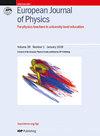平面扩展光源的调查性测光实验
IF 0.8
4区 教育学
Q4 EDUCATION, SCIENTIFIC DISCIPLINES
引用次数: 0
摘要
点光源照度随距离的反平方衰减规律是基础光学理论中的一个常见概念,很容易证明它是以光源为中心的球面波前沿传播的直接结果。但对这一规律进行实验验证的情况却少之又少,而对延伸光源的照度随距离衰减的研究更是少之又少,这在某种程度上是一个未知的课题。我们提出了一个科学实验,利用智能手机的光传感器收集照度数据,并将其作为光源到传感器距离和方向的函数。通过这一过程,学生可以认识到平方反比定律的有效性极限,并确定所选点状光源(如智能手机的白色 LED 手电筒)的光通量。更有趣的是,在处理扩展光源(如显示白色图像的笔记本电脑液晶显示屏)时,衰减趋势会出现微妙的特征,尤其是在距离小于光源尺寸时。我们通过让学生参与真正的科学调查,设想通过实验测量获取数据、根据观察到的模式构建模型以及最后进行模型测试等步骤,对这些特征进行了详细分析。我们从朗伯光源的理论处理入手,为平面发射器的一般建模提供了指导性公式。这样,学生们就能够量化扩展光源的发光发射及其与朗伯光源的偏差。本文章由计算机程序翻译,如有差异,请以英文原文为准。
Investigative photometry experiments on planar extended-light sources
The inverse-square decay law of the illuminance of a point light source with distance is a common notion of basic optics theory, which is readily demonstrated to be a direct consequence of the propagation of spherical wave fronts with the centre at the light source. It is far less common to address the experimental verification of this law and, even less, to study the illuminance decay with the distance of extended light sources, which somehow represent an unknown topic. We propose a scientific experiment where the light sensor of a smartphone is used to collect illuminance data as a function of the source-to-sensor distance and orientation. Through this procedure, students can realize the limit of validity of the inverse-square law and determine the luminance flux of the chosen point-like light source (e.g. the white LED flashlight of a smartphone). More interestingly, when dealing with extended sources (e.g. the LCD of a laptop displaying a white image) subtle characteristics of the decay trend emerge, particularly for distances lower that the source size. A detailed analysis of these characteristics is presented though a process allowing student engagement in a real scientific investigation, envisaging steps of data acquisition through experimental measurements, model construction on the basis of the observed patterns, and finally model testing. We provide a guided formulation for the general modelling of planar emitters, starting from the theoretical treatment of Lambertian sources. In this way, students are able to quantify the luminous emission also for extended sources and their deviation from a Lambertian behaviour.
求助全文
通过发布文献求助,成功后即可免费获取论文全文。
去求助
来源期刊

European Journal of Physics
物理-物理:综合
CiteScore
1.70
自引率
28.60%
发文量
128
审稿时长
3-8 weeks
期刊介绍:
European Journal of Physics is a journal of the European Physical Society and its primary mission is to assist in maintaining and improving the standard of taught physics in universities and other institutes of higher education.
Authors submitting articles must indicate the usefulness of their material to physics education and make clear the level of readership (undergraduate or graduate) for which the article is intended. Submissions that omit this information or which, in the publisher''s opinion, do not contribute to the above mission will not be considered for publication.
To this end, we welcome articles that provide original insights and aim to enhance learning in one or more areas of physics. They should normally include at least one of the following:
Explanations of how contemporary research can inform the understanding of physics at university level: for example, a survey of a research field at a level accessible to students, explaining how it illustrates some general principles.
Original insights into the derivation of results. These should be of some general interest, consisting of more than corrections to textbooks.
Descriptions of novel laboratory exercises illustrating new techniques of general interest. Those based on relatively inexpensive equipment are especially welcome.
Articles of a scholarly or reflective nature that are aimed to be of interest to, and at a level appropriate for, physics students or recent graduates.
Descriptions of successful and original student projects, experimental, theoretical or computational.
Discussions of the history, philosophy and epistemology of physics, at a level accessible to physics students and teachers.
Reports of new developments in physics curricula and the techniques for teaching physics.
Physics Education Research reports: articles that provide original experimental and/or theoretical research contributions that directly relate to the teaching and learning of university-level physics.
 求助内容:
求助内容: 应助结果提醒方式:
应助结果提醒方式:


